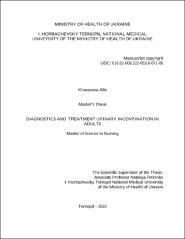DIAGNOSTICS AND TREATMENT URINARY INCONTINATION IN ADULTS
Abstract
Urinary incontinence is widespread throughout the world. This research project aims to study the etiological factors and pathogenetic mechanisms of various forms of urinary incontinence, to develop directions and methods for diagnosing, effective
treatment of incontinence in adults. The data for this project was collected through: epidemiological, clinical (observation, comparison, measurement), statistical methods. All patients with symptoms of urinary incontinence require constant medical supervision, careful hygiene care and organization of life to improve the quality of life. For timely effective treatment of continence in adult patients,
medical personnel should develop a plan of diagnostic measures, which should take into account all the risk factors for the ormation of urinary incontinence in each patient individually, taking into account the characteristics of his age, gender,
underlying disease, functional characteristics of the body. It should include a thorough history taking, physical, modern laboratory, instrumental diagnostic methods. A complex of therapeutic measures for urinary incontinence in adults should include mandatory non-drug methods of therapy (bladder training, exercises for the pelvic muscles, normalization of physical activity, a diet that promotes weight loss), drug treatment using modern drugs (anticholinergics, drugs of mixed actions,
antagonists of α-adrenergic receptors, antidepressants (tricyclic or serotonin and norepinephrine reuptake inhibitors)). In case of ineffectiveness of non-drug and drug treatment, surgical (surgical) intervention is indicated. The volume of the operation is
determined individually, taking into account gender, age, underlying disease. The ultimate goal of treating incontinence in adults is to normalize urination and improve the quality of life.

